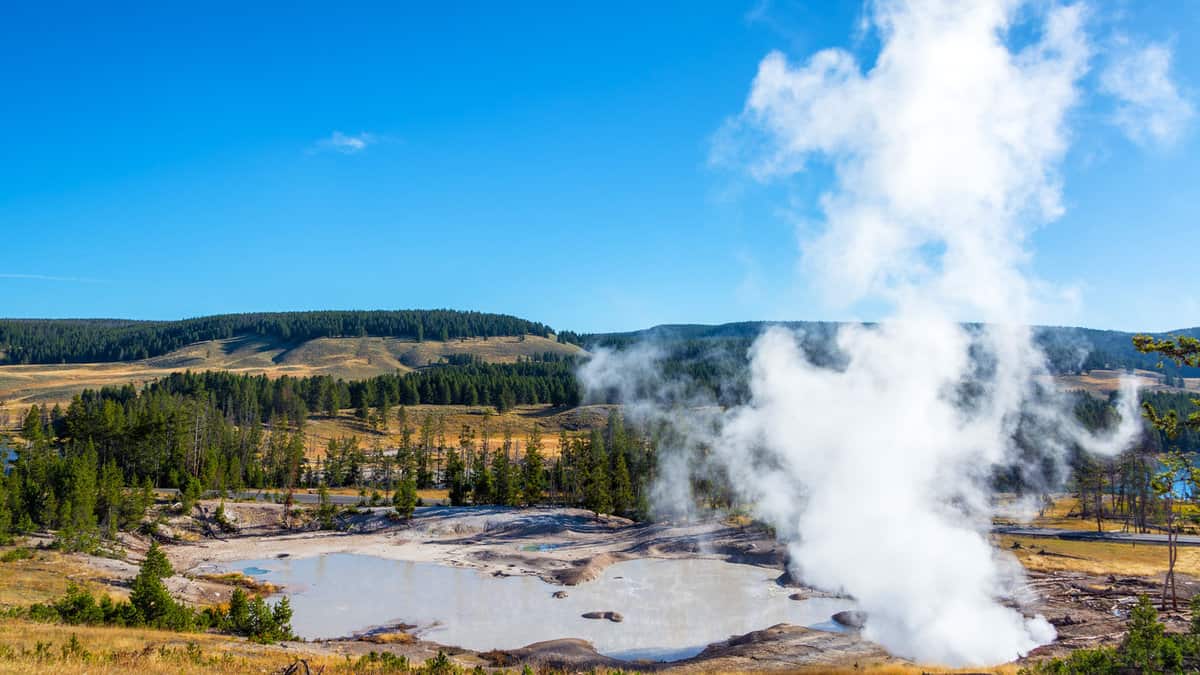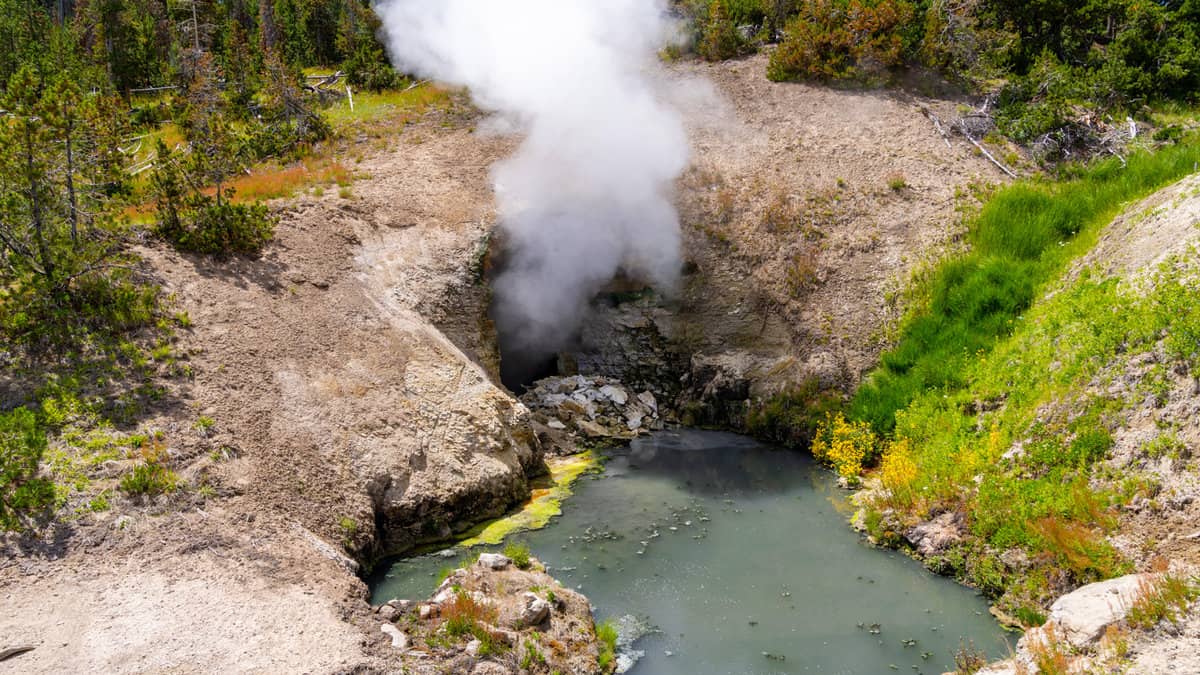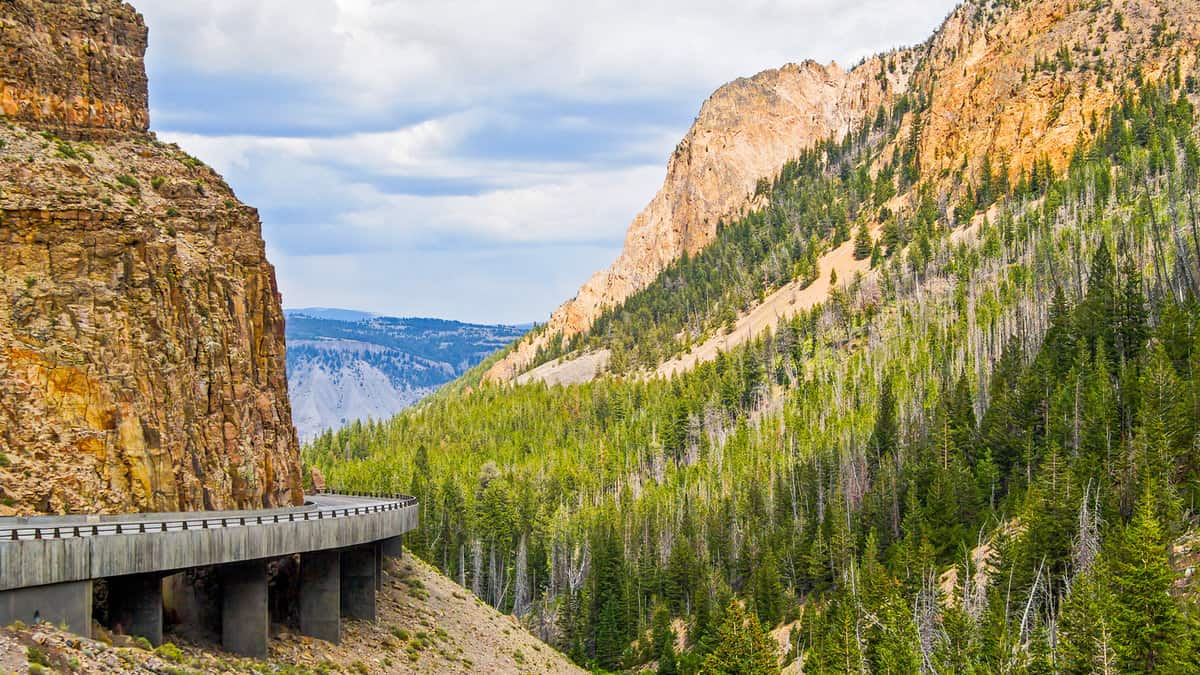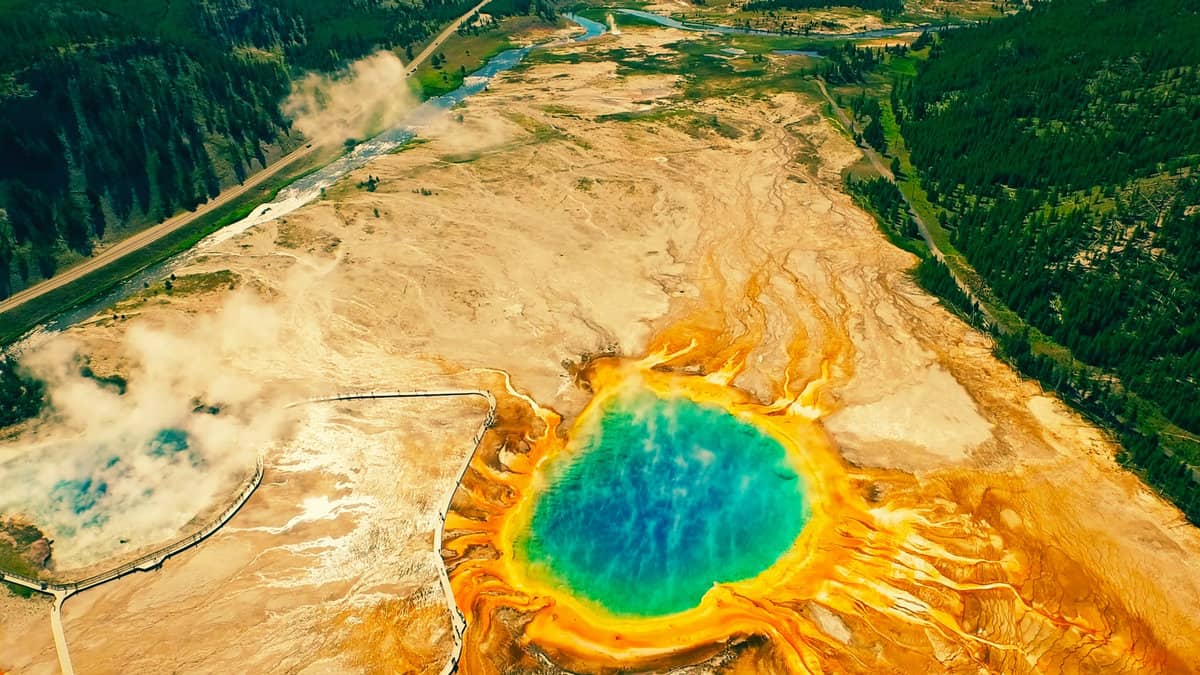Beneath the surface of Yellowstone National Park lies a volcanic powerhouse, fueling a landscape of otherworldly wonders.
Among them, you'll discover the mesmerizing Mud Volcano Area — a strange and volatile place where sulfurous steam vents from the earth.
Not to be confused with lava-spewing peaks, this muddy marvel brews its captivating drama. Discover what secrets hide below the surface, from colorful microbes to rumbling gases.
While exploring the wonders of Yellowstone's Mud Volcano area, it's important to understand the distinction between this unique geothermal feature and the broader geological phenomenon of mud volcanoes.
Mud volcanoes, in general, are natural formations created by the eruption of mud, water, and gases, often found in areas with subterranean geological activity.
Unlike traditional lava-producing volcanoes, these mud volcanoes are formed by the mixing of hot water and mineral deposits deep beneath the Earth's surface.
In contrast, the Mud Volcano area in Yellowstone National Park is a specific geothermal region, characterized by its diverse range of geothermal features, including hot springs, fumaroles, and the namesake Mud Volcano.
This area, rich in geological and ecological diversity, stands as a testament to the park's dynamic natural processes, offering visitors a glimpse into the Earth's vibrant geothermal activity.
Understanding the Mud Volcano

Yellowstone National Park is home to many geothermal features, including mud volcanoes.
The park's Mud Volcano Area was named during the 1870 Washburn Expedition when Nathaniel P. Langford, Yellowstone's first superintendent, described it as a "seething, bubbling mass of mud."
Mud volcanoes are not true volcanoes but hot springs containing mud and gases. They are formed when water mixes with volcanic ash, clay, and other minerals.
Their eruptions are unpredictable and potentially dangerous, as they discharge mud, water, gas, and even rocks.
Yellowstone's mud volcano area is home to several mud volcanoes, including Black Dragon's Caldron, Dragon's Mouth Spring, and Mud Geyser.
Read more on Yellowstone's geysers here: Yellowstone Exclusive – The World’s Largest Geyser Basin

These mud volcanoes are constantly changing due to volcanic activity and the movement of the magma chamber beneath the park.
In fact, Yellowstone National Park is atop a supervolcano, so it has the potential for a major eruption that could have global consequences. However, the chances of a major eruption happening soon are extremely low.
Learn more about Yellowstone's supervolcano facts here: Yellowstone’s Supervolcano: Understanding the Science and the Myths
The Chemistry of Mud Volcanoes
Yellowstone's mud volcanoes stand out for their extreme acidity, like battery acid, created when hydrogen sulfide gas reacts with oxygen to form sulfuric acid.
Carbon dioxide from underground magma mixes with groundwater and surfaces as bubbling mud and steam vents. The distinct chemistry enables diverse microbes that color the mud pots vividly.
Exploring Yellowstone's Mud Volcano Area
Begin your journey at the trailhead, conveniently located on the west side of the Grand Loop Road, just 5.8 miles north of Fishing Bridge Junction.

Follow the meandering boardwalks guiding you through this dynamic, steam-filled landscape. Then, check out the Mud Volcano Area, the Dragon's Mouth Spring — a vast, echoing cavern that continuously releases a stream of steam and water.
As you draw near, prepare to be captivated by a deep, rumbling symphony created by the rushing steam and water through its narrow opening.
Next, stop by the Mud Geyser, celebrated for its capricious eruptions. While its activity has waned over time, witnessing the bubbling mud and rising steam is captivating.
But be prepared for strong sulfuric smells, especially in the heat. Despite the odor, TripAdvisor users share that the area's geothermal activity is intriguing.
Also, visitors say the parking lot is relatively small and can fill quickly, so patience may be needed when finding a spot.
The Role of Microbes in Mud Volcanoes
Mud volcanoes exist because of microbes, tiny factories breaking down dead organic matter into more basic chemicals.
In the process, they release gases like methane and carbon dioxide. They also create a sticky glue-like substance scientists call "extracellular polymeric substances" (EPS). This EPS binds together sediment into mud deposits that build up structures.
So communities of microbes produce the ingredients for mud volcanoes — the gases provide the fuel, the mud makes up the building blocks, and the microbial EPS glue holds everything together.
The chemical reactions of microorganisms churning underground make mud volcanoes possible.
Seismic Activity in Yellowstone
The University of Utah Seismograph Stations, responsible for operating the Yellowstone Seismic Network, locates between 1500-2500 earthquakes annually in the region.
While most of these earthquakes are small and go unnoticed by visitors, the park experiences occasional swarms of larger earthquakes.
Despite the high level of monitoring, predicting volcanic eruptions is complex, and Yellowstone's mud volcanoes and other geothermal features are highly unpredictable.
In recent years, the park has experienced several swarms of earthquakes, including one in August 2023.
In 2020, there were reports of other significant earthquake swarms in Yellowstone National Park, with one swarm of 91 earthquakes occurring daily.
The Future of Yellowstone's Mud Volcano
According to a recent update by the Yellowstone Volcano Observatory (YVO) in October 2023, the Yellowstone Caldera has been subsiding at a rate of about 2-3 cm (approximately 1 inch) yearly since 2015.

The rate of deformation, which refers to changes in the ground's shape, varies seasonally due to variations in water load both above and below the ground.
During the summer, the subsidence is interrupted, or a minor uplift as groundwater recharge from snowmelt causes the ground to swell slightly. The subsidence resumes in late October, as noted in multiple reports from the USGS.
Explore Yellowstone's Mud Volcano Safely and Discover Nature's Wonders
Visiting Mud Volcano is an exceptional opportunity to witness the Earth's raw volcanic forces up close. However, Yellowstone officials urge visitors to do the following:
- Stay on boardwalks and designated trails.
- Never run, push, or shove.
- Supervise children at all times.
- Do not scratch hydrothermal mats.
While Mud Volcano's outbursts appear small, they can still burn and injure visitors who get too close.
So take your time, explore responsibly, and discover why Yellowstone's one-of-a-kind volcanic features have fascinated visitors for over a century.
